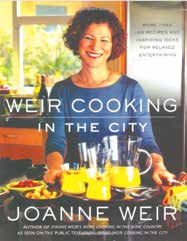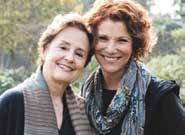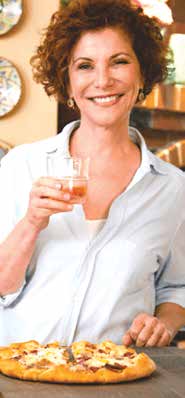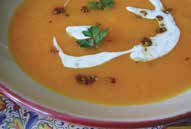
By David Landis–
She’s the Energizer Bunny of the culinary world. San Francisco’s chef Joanne Weir seems to do it all: she authors cookbooks; conducts culinary/travel tours in Morocco, Spain, and Italy (and more); creates tantalizing new recipes; submits recipes for such esteemed publications as The New York Times; oversees the hot Mexican restaurant Copita in Sausalito; and hosts one of the most popular cooking shows on PBS. The Gay Gourmet caught up with her during the pandemic to find out about her new TV series, how she’s adapting tours during the COVID-19 pandemic, and all things San Francisco.
The Gay Gourmet: First off, I have to ask, how do you do it all?
Joanne Weir: I really love what I do and have a lot of energy. I also have a hard time saying no! I get excited by every project and love the creativity involved. There’s a saying on my desk, “Passion keeps me realizing my possibilities.”

GG: Where does your passion for cooking come from?
JW: My grandfather had a beautiful berry farm in western Massachusetts. I used to go with my mom to grandfather’s farm—we’d have picnic lunches: homemade chicken sandwiches, maple walnut ice cream that he churned, eggs from the farm. I thought all kids ate like this, until I went to school.
GG: What brought you to California?
JW: While lunching at my grandfather’s farm, I would ask my mom, “What’s that hill over there with beautiful views?” She’d say, “That’s California.” I first lived in Boston and taught high school and fine arts, then moved to California with my ex-husband. After that, I went back to cooking school, studying with Madeleine Kamman (1930–2018) in France. Madeleine is an icon—she was difficult, but a genius. She expected a lot from us. I was lucky because she liked me. I knew that what I really wanted to do was cook. Halfway through, half the people quit because she was so tough. But I spent two months with her in France.
GG: You’ve also had a stint with Alice Waters at Chez Panisse. What was that like?
JW: Before I studied with Madeleine, I wanted to work at Chez Panisse. A friend said she could get me an “in” with Alice because of the fact that I practically grew up on my grandparent’s farm (i.e., lived and understood “farm to table”). When I came back to California, I tried out for a week or ten days. I got the job—it was my first restaurant job! It was an extraordinary experience. I was there for 5 years and worked upstairs, downstairs, in pastry—but mostly in the café. I also was a taster at Café Fanny for a year. I still remember when I worked at the upstairs café, I put Alice’s daughter Fanny on the counter—she must have been 4 years old. I made a salad, Fanny tried it and said, “Eww, too acid!” I remember thinking, “What a gift to have a palate like that.” I’m still “the family” at Panisse. In fact, Alice wrote the forward to my most recent book, Kitchen Gypsy.

GG: You seem to have a big LGBTQ following. Why is that?
JW: I want to know why!!! Perhaps it’s because LGBTQ folks appreciate a nice lifestyle and the finer things in life: good food and travel.
GG: How has Covid affected your culinary/travel tours?
JW: It’s frustrating. I had tours set up in May and October of 2020. I moved all of them (90 people) from 2020 to 2021 and now I have to move them to the fall. I’m hoping that will work. I take care of everything—all the details—except the airfare. For example: in Marrakesh, people fly in, a driver picks them up to stay at a gorgeous villa. We usually have 5 hands-on cooking classes, so I look for places that have big kitchens and/or outdoor kitchens. We go on excursions and we cook food from that region. My relationships allow for special experiences you wouldn’t normally have. For instance, in Marrakesh, we go inside the souks and to the Berber Market. You don’t have to be an accomplished chef to take these classes. Everybody gets a chance to get in there and cook. I want to instill confidence in people—when the recipe works, everyone claps—and then they want to cook another dish. I cook with Bahija, the chef at the riad where we stay. One of the things we do is have everybody (18 people) making their own tajines. We line up all the tajines outside—the clay pots with the firewood. It’s incredible. You see people’s mouths drop.
GG: You also run a very popular Mexican restaurant in Sausalito, Copita. Given your fondness for Mediterranean cooking, how did that come to be?
JW: I’m good friends with restaurateur Larry Mindel. I was on Larry’s boat and gave him my new cookbook, Tequila, and he said to me, “I make the best margarita.” I said to him, “No, I make the best margarita.” He said, “You make yours; I’ll make mine.” We had a little competition. His was good, mostly tequila, but he turned to me and said, “Damn it, Joanne. Yours IS the best margarita I’ve ever had. If I ever find a location to open a Mexican restaurant, would you open it with me?” I’d just had 2 margaritas, so what do you think I said? That restaurant, my first, has been another extraordinary experience.

GG: What are your favorite San Francisco restaurants?
JW: I love Kokkari (Greek) and I also love Zuni Café (California)—it’s my “Chez Panisse in the City.” Everything is delicious. Barbacco (Italian) is fun and I also love NOPA (Mexican), which has a great chef—Lawrence was my assistant in Italy. I also love Out the Door (Vietnamese) in Pacific Heights.
GG: Your TV shows are so fun. They air on PBS and Create TV. And you shoot them right from your San Francisco kitchen?
JW: Yes, I’ve been on the air for 20 years, which is really great for a television show. We are launching 13 new shows for Plates and Places—they air on Thursdays and Saturdays on KQED TV locally (check local listings). The shows air in 94.6% of households in the U.S.! People love it because it’s both a travel AND a food show. I’ve filmed shows in Spain, Italy, Greece, Salzburg, and Budapest. The final show this season is my home city, San Francisco.
GG: Speaking of which, why are you so drawn to San Francisco?
JW: I love it. There’s no other place I would like to live. I love the proximity to the wine country and the proximity to great ingredients. People here are nice and happy. I still think San Francisco has that spirit. It’s a beautiful city.
Here are some of Joanne Weir’s easy-to-cook recipes, perfect during quarantine:

Roasted Butternut Squash and Carrot Soup with Honey Pecan Butter
1 small butternut squash, about 2 pounds
2 pounds carrots, peeled and cut into 3-inch pieces
3 tablespoons toasted and finely chopped pecans
1 tablespoon honey
3 tablespoons butter
2 slices bacon, diced
1 large yellow onion, chopped
6 cups chicken stock
1/2 cup heavy cream
1/4 cup orange juice
Large pinch of freshly grated nutmeg
Salt and freshly ground black pepper
Whole leaves of flat-leaf parsley as a garnish
Preheat the oven to 375°f.
Halve the squash from top to bottom and place it, cut side down, on an oiled baking sheet. Place the carrots around the squash. Toss to coat with olive oil. Bake until the squash can be easily skewered, 45 to 60 minutes. Cool for about 20 minutes. With a spoon, remove the seeds and discard. Scrape the pulp and reserve. Discard the skin.
For the honey-pecan butter, mash 2 tablespoons butter with the pecans and honey. Season to taste with salt and pepper. Roll the butter in plastic wrap into a cylindrical shape 1-inch in diameter. Store in the refrigerator until well chilled and firm.
Melt the remaining 1 tablespoon of the butter in a soup pot over medium heat. Add the bacon and onions and cook, stirring occasionally, until the onions are soft and the bacon is just turning golden, about 7 minutes. Add the squash, carrots, and stock and simmer until the squash falls apart and the carrots are tender, about 30 minutes. Let cool for about 20 minutes. In batches, puree the soup in a blender on high speed, 3 minutes per batch, until very smooth. Strain through a fine mesh strainer into a clean soup pot and add the cream, orange juice, and nutmeg. Season to taste with salt and pepper. If the soup is too thick, correct the consistency with additional water or stock.
Ladle the hot soup into soup bowls. Cut 1/4-inch slices of the honey-pecan butter and float one in each bowl of soup. Garnish with parsley leaves and serve.
Serves 6
Eggs in Purgatory Amatriciana

2 tablespoons extra virgin olive oil
2 ounces guanciale or pancetta, 1/4-inch dice
1 small red onion, minced
Pinch of crushed red pepper1 clove garlic, minced
1/4 cup dry white wine
2 ½ cups canned Italian tomatoes, peeled, seeded, and pureed
Kosher salt and freshly ground black pepper
4 large eggs
1/4 cup finely grated Parmigiano
4 basil leaves, torn
Toasted bread or focaccia
Warm the olive oil in a medium frying pan over medium high heat and add the guanciale or pancetta and cook, stirring occasionally, until golden and crispy on all sides, 3 to 4 minutes. Add the onions and crushed red pepper and cook until the onions are soft, 7 minutes. Add the garlic and cook 1 minute. Add the white wine and reduce by half. Add the tomatoes and simmer until the sauce thickens slightly, 10 minutes. Check the thickness by pulling a wooden spoon across the bottom of the pan and stays separated. Season to taste with salt and pepper.
Make 4 indentations in the sauce. Break the eggs, one by one into a small bowl, and with the spoon, add one egg into each indentation. Cover and cook until the whites of the eggs are firm but the yolks are still runny, about 3 to 4 minutes. Season the eggs with salt and pepper.
Sprinkle the top with Parmigiano Reggiano and basil and serve immediately with toasted bread or focaccia.
Serves 2
Look for additional recipes from Joanne Weir in the next issue of the San Francisco Bay Times!
For more information, visit Joanne Weir online at: www.joanneweir.com
For information about Copita restaurant in Sausalito, visit: https://www.copitarestaurant.com/
David Landis, aka “The Gay Gourmet,” is a foodie, a freelance writer, and a PR executive. Follow him on Instagram @GayGourmetSF, on Twitter @david_landis, email him at: david@landispr.com or visit him online at www.gaygourmetsf.com
Published on January 28, 2021
Recent Comments